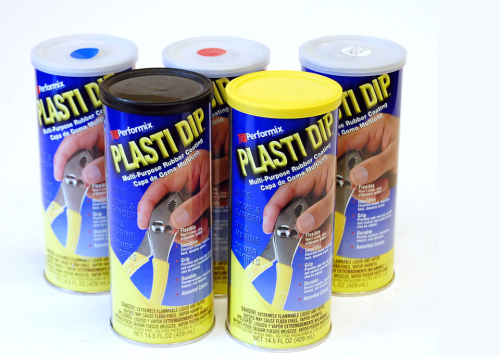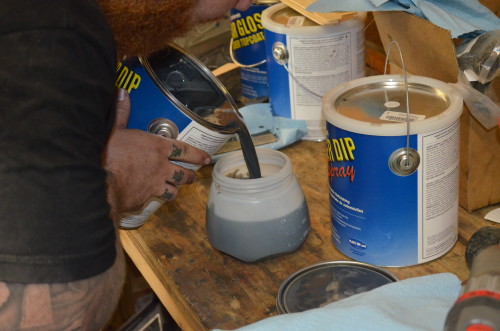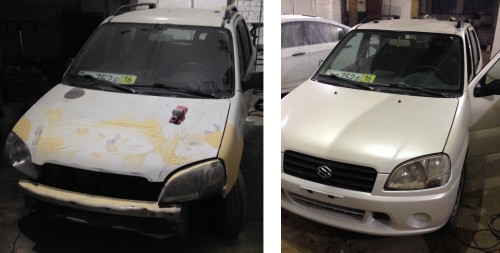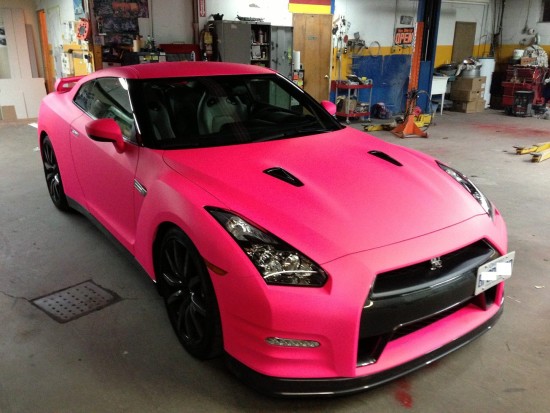Today, rubber paint for cars is enjoyed increasingly by car owners. Most recently appeared in the Russian market and post-Soviet space, she has already managed to acquire a multitude of fans. This is largely due to the versatility of rubber paint, which is used in professional auto-tuning, in domestic workshops and in large-scale production, is used for painting not only metal, but also wood, plastic and glass.
Content
Rubber paint Plastidip - its properties
The most famous among Russian car enthusiasts is Plasti Dip International. Rubber Paint Plasti DIP is used in the following cases:
- for complete briefs of the body of the car;
- staining of individual parts (disks, bumpers, radiators, torpedo);
- for temporary painting (shooting in the clip / film, auto expense), followed by easy paint removal;
- protection during the transportation and operation of the car;
- waterproofing.

Plasti Dip, like the usual paint, is produced throughout the diversity of colors and textures: it is a glossy, matte, fluorescent, with a pearl or metallic tint. An interesting feature of rubber paint is the ability to mix colors for your original design solutions.
Dignities and disadvantages of liquid rubber
advantages of Plasti Dip and similar paints
- Does not require a complete color parsing for painting.
- It does not need an ideal state of paintwork and in special preparation of the body surface. You can paint even damaged parts or applied on top of the old paint.
- Does not require special additives or glue.
- Easily removed, while not leaving the slightest traces on the LCP. After removing rubber paint, it does not even need a washing.
- The process of full painting takes no more than 12 hours.
- The complexity of the body shape does not matter. Great for staining with grills, wheels, icons, and even interior parts.
- An excellent means for masking scratches and chips. It is easy to repaint the body damaged during an accident.
- The ability to use as a protective material: perfectly protects the main LCP from scratches and corrosion.
- The highest resistance to adverse effects of natural factors. Plasti DIP retains all its protective properties at temperatures from -34 to 93 ° C.
limitations
- It does not differ in durability, significantly inferior in this other species and vinyl film. Paints of bright colors quickly burn into the sun in the hot regions.
- The handicraft painting is often turning around the appearance of the "effect of orange peel" (porous, uneven surface). Professional painting completely eliminates such defects.
- Rubber paint "Afraid" of all solvents based on alcohol and gasoline, as well as tar, bitumen and various resins.
![maxResDefault [1]](https://prosedan.ru/images/prosedan/2016/03/maxresdefault11-500x281.jpg)
Despite the relative novelty of the product, the reviews of users of rubber paint have already managed to get a network. In general, they repeat the aforementioned characteristics of Plasti Dip and its analogues: Car owners praise paint for the ease of working with it, dryness, trouble-free removal and protective properties. The discontent of the same users causes: high price, short-life (fading in the sun) and low resistance to some aggressive procedures (for example, washing on a car wash). In fairness it is worth noting that most of the spokes painted the car on their own using a canister.
Many converge on the fact that rubber paint is an excellent coating for small parts or plastic (on which the same vinyl film does not hold as follows). In addition, it should be remembered that gasoline and diesel engines - a threat for rubber paint, so they should be avoided to enter the surface of the body during the refueling, and even more so never to use as solvents for incited contaminants.
Basic Rules Painting, Solvents
Before moving to the description of the process itself, it is necessary to recall that rubber paint can cause poisoning symptoms at a high concentration of its vapors in the air. Therefore, be sure to be a respiratory mask, glasses, gloves and do not forget about careful ventilation of the work room. In addition, it is flammable (the highest category of flammability) substance, therefore, in order to avoid a fire, you should remove any sources of fire, sparks and electricity.
preparation of the workplace and body
Although rubber paint is positioned as a coating that can be applied on top of the old LCP, it is reasonable to do it only if it is integer. If there are peeling fragments, the fragments of old paint can damage "liquid rubber". That's why:
- how to wash the damaged area;
- remove the paint with a spatula with a spatula with a slightly sandpaper;
- wash again, after which it will rain full drying and degrease the plot;
- thoroughly wipe the body, removing all sorts of solvent traces (experts advise to avoid kerosene, and use the White Spirit).

If you plan to paint only certain places, the rest must be closed with a film, and the space under the hood (from the radiator side) is to cover with a sheet of cardboard. This will prevent paints from entering mechanical nodes of the car. When painting only outdoor elements (especially disks), they are more convenient to remove.
paint and nuances work with her
This kind of paint has been popular, as it is possible to paint with Plastidip or its analogues, not only in the garage, but even outdoors. The substance does not require heating and sold in fully ready for use.
Painting consumption depends on the preferences of the owner of the car. If this is not a temporary painting for the exhibition, and the full staining for long-term use, to the full painting of the passenger car leaves 10 to 15 liters. Separate elements (bumper, wings, mirrors) will require no more than one or two cans.

Several useful tips:
- It is better to produce in spring / summer or to achieve 18-22 ° C in temperature.
- Correct the number of layers. For example, when painting over the old color, it is best to apply 5 layers. Try to make each of them as thinner as possible, and after applying the next layer, wait at least 15 minutes.
- If items formed in the process, you should not panic. Instantly remove them with any darous material.
stages of painting
Painting algorithm looks like this:
- start from the rear rack and move to the roof;
- color the roof;
- left rack;
- lid trunk, behind it conjugate bumper;
- the left wing, after - the front door, the adjacent wing and the whole "face" (part of the car from the front edge and up to the windshield);
- hood (start on the left and move to the center);
- lattice and rear headlight bar;
- go to the rest of the doors, front and rear right wings.
It is this sequence that allows you to prevent the sedimentation of dust on the just painted areas.

Several useful tips:
- a sprinkler or spray nozzle must be kept with a constant slope with respect to the stained place.
- it is also not recommended to increase the distance - this is fraught with the appearance of the very "effect of orange peel".
cARE FOR FREE CAR
Caring for paint Plasti Dip does not require any special procedures or skills. This paint is noticeably less susceptible to pollution than, for example, acrylic enamel, and it is so easy. However, there are some nuances:
- you can not use aggressive chemicals;
- it is impossible to use gasoline solvents, White spirit or alcohol.
Conclusion
Rubber paint is remarkably suitable for self-tapeding, since it does not require any special skills, nor professional equipment, nor the "sterile" premises. Simple and the process of painting: you can forget about the torment with the plated layers. Nevertheless, as follows from numerous reviews, handicraft painting rarely can be compared to the aesthetic form and durability with the work of a professional.
Related Materials
- Stove 2110, bad warm stove 2110, VAZ 2110 heating system, repairing the heating system VAZ 2110 with their own hands
- VAZ 2114 stove blows with cold air, stove 2114, bad warm stove VAZ 2114, device and repair of heating VAZ 2114 do-it-yourself, removing the stove VAZ 2114
- How to subdominize the car. How to put a jack. Types of jacks for cars.
- VAZ 2109 Fuse Block, VAZ 2109 Fuse Block Carburetor, VAZ 2109 Fuse Block Injector, Old VAZ 2109 Fuse Block, VAZ 2109 Fuse Block, VAZ Fuse Block 2109
- Car exhaust gas catalyst, faulty catalyst, pluses and cons of the catalyst, how to change the catalyst on the planeencitel
- Stove blowing cold air VAZ 2114, badly blowing the stove VAZ 2114, why badly blowing the stove VAZ 2114
- How to find out the owner of the car by the number of his car, check the car by the number of the traffic police machine, check the car by the state number of the car for free
- How to choose Used tires, Useful Tips
- Winter car road, pressure in passenger car tires in winter, good battery for the car in winter, whether to warm the car in winter
- In winter, the car is poorly started. How to make a car in winter, do you need to warm up the car in winter, useful tips
- Economy fuel consumption machines, the most economical car consumption
- Tires brands for passenger cars, labeling of car tire labeling, residual passenger car tire protector, how to pick a tire on a car brand, car tire tread pattern
- Working transmission operation, mechanical gearbox clutch work, driving with manual gearbox, useful tips
- Rear beam Peugeot 206 sedan, rear beam device Peugeot 206. Rear beam Peugeot 206 Malfunction, repair of the rear beam Peugeot 206
- Diesel fuel in winter, additive for diesel fuel in winter, how to choose the best diesel fuel
- Diesel winter does not start. How to start diesel in winter, heating diesel in winter.
- Japanese bridgestone tires, winter studded bridgestone tires, bridgestone tires brand
- Tire marking decoding for passenger cars, labeling wheels, how to choose the right tires on the disks
- Diesel engine in winter, launch of the diesel engine in winter, what oil to fill in a diesel engine in winter, useful tips
- LED backlight of the car, the backlight of the bottom of the car, the backlight of the legs in the car, the backlight in the door of the car, the backlight of the car is fine
- Recovered tires, bus tire, restored tire protector, can I use them
- Choose winter tires, which is a winter tires, which pressure in winter tires should be marked with winter tires, how to choose the right winter tires, the best winter tires 2019
- Steering rail rail, knock of steering rack, reasons for the knock and repair of the steering rack do it yourself
- Cameless car tires, a set for repair of tubeless tires, repair of the cannon-free tire do it yourself
- Russian tires, Russian tires Winter, Russian All-season tires, Voronezh AMTEL tires, Tires "Matador Omsk Tire", Kama-tires are world-class bus
- How to open a car without a key. Lost the key from the car what to do, the key from the car inside the car
- Silent tires, quiet winter tires, quiet studded bus, which tires to choose, overview tires
- Rules of safe driving of the car in the rain and slush, safe driving of the car for beginners
- Rust converter which is better for cars, rust converters to choose how to use rust transducer, professionals
- Polishing the body of the car do it yourself, how to choose a polishing paste, useful tips
- Engine durability, engine life, how to extend engine life
- Knock in the car. Knock when moving the car. What can knock in the car. How to determine the cause of the knock.
- ABS car, what is ABS car, ABS system malfunction, ABS diagnostics
- Overtaking a car when you can start overtaking a car, rules of traffic rules
- Fuel pump VAZ 2110, VAZ 2110 gas station scheme, VAZ 2110 fuel pump device, VAZ 2110 gas station repair,
- Automotive antennas for radio, automotive antenna device, car antenna do it yourself
- Front suspension Kalina, device front suspension Kalina, knock in front suspension Kalina, repair of front suspension Kalina
- Shock absorber Oil, best oil shock absorbers, pumping oil shock absorbers, how to properly pump oil shock absorber
- Clutch malfunctions, touches clutch, causes a clutch malfunction, how to eliminate
- Viscounts of the fan, work uniforms of the fan, malfunction of the ventilator fan, repair of the ventilator fan







Comments